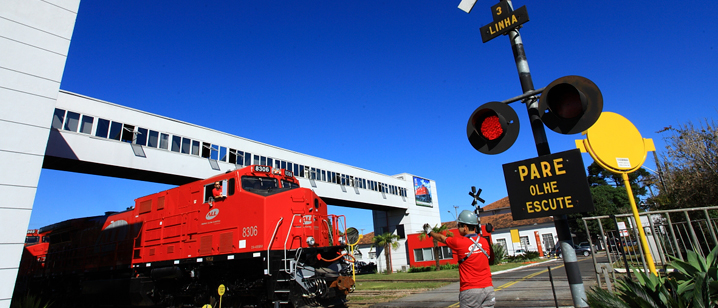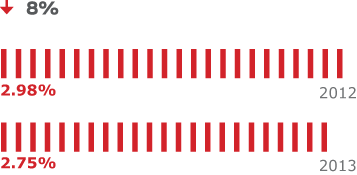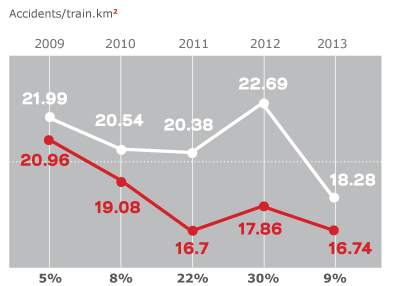Safety
Safety management progressed with the creation of the ALL Safer program

Personal safety and occupational health
Managing safety
ALL pays as much attention to the safety and occupational health of its employees as it does to productivity and growth. The question is handled systematically and objectively with action plans, predetermined targets and the monitoring of challenges and advances. To achieve its goals, the company invests in diverse tools to increase employee knowledge, awareness and commitment to safety standards. Management of this question is underpinned by five principles (see table on Health and safety principles). These are drilled into each employee upon induction into the company and reviewed during all safety and production meetings and training programs.
In 2013, safety management progressed with the adoption of the ALL + Segura (ALL Safer) program, which established guidelines and standards to be followed in all company routines with a view to boosting personal safety performance. The initiative increased the number of safety, occupational health and accident prevention tools in use from six to nine:
- PPE management: this encourages leaders to use all necessary personal protective equipment, providing an example of proper conduct to attenuate the risk of accidents. It also provides for the control of the delivery, use and return of PPE.
- Safety and Environment Schools: aimed at guaranteeing that each employee receives proper training in these areas, ensuring they do not carry out activities for which they have not been duly trained.
- Accident Analysis and Investigation: ensures that any accident is logged and reported immediately. It is then analyzed by the leader responsible, generating learning that helps avoid recurrence.
- Safety Induction for Technicians and Supervisors: aimed at training all new employees and third parties in safety, ensuring nobody is exposed to risks for which they have not been trained.
- Risk communication: requires that all deviations in conduct related to safety standards be logged and communicated to leaders and used as an example to prevent the occurrence of accidents.
- Permission to Work and Preliminary Risk Analysis: document through which the supervisor of each area authorizes activities after evaluating the risks in the environment and the tasks to be executed by employees or third-parties.
- 5-minute Meeting: daily safety dialogue conducted by the leader. This takes place at the beginning of each shift, covering the risks related to daily activities.
- Weekly Safety Inspection: conducted by the supervisor, who should record and address any unsafe conditions in the work environment.
- Safety and Environmental Standards: these define the mandatory safety and environmental routines and standards for every situation.
Every new employee hired by ALL receives training in this program, its fundaments, tools, practical applications, as well as the responsibilities of each function. The content is reviewed periodically. Furthermore, in the weekly safety meetings promoted by the company at its units, and in the Corporate Safety Committee, which also meets weekly, the first item on the agenda is the analysis of indicators for each one of the tools. These indicators are used in a safety ranking which is the basis for an internal performance competition. The results of this competition are tracked on a monthly basis by senior management and are also reflected in employees' variable remuneration.
Indicators of the program's success in improving personal safety management at ALL include the number of Risk Communications, which increased from 28 thousand in 2012 to 35 thousand in 2013 – with a solution rate of 95% –, and the number of Weekly Safety Inspections undertaken, which rose from 18 thousand to 26 thousand in the same period.
This assertive approach has ensured good results: in 2013 the Accident Frequency Rate (AFR) fell 8% compared with 2012. The number of days lost accidents was reduced from 126 (2012) to 112 (2013). For 2014, the target is a 15% reduction compared with 2013.This rate is calculated based on the occupational accident frequency rates, using only accidents that generated days lost, in accordance with Brazilian labor legislation.
Using GRI methodology (see table below), the rate based on the total number of accidents (with and without days lost) among employees and third-parties was also calculated. There was a drop in the number of days lost in the period, indicating a reduction in the number of serious accidents. Unfortunately, there was one fatal accident involving an employee during the year; in 2012 there were three fatalities.
Occupational health and frequency indicators 1
| 2012 | 2013 | |||
|---|---|---|---|---|
| Employees | Men | Women | Men | Women |
| Accidents2(total) | 155 | 3 | 180 | 2 |
| Accidents3(rate) | 0.79 | 0.89 | ||
| Days lost4 (total) | 1,818 | 30 | 1,158 | 5 |
| Days lost (taxa) | 9.22 | 5.70 | ||
| Absences5 (days) | - | 27,536 | 1,515 | |
| Absenteeism (rate) | - | 142.39 | ||
| Third parties | ||||
| Accidents (total) | 34 | 1 | 39 | 1 |
| Accidents (rate) | 0.17 | 0.20 | ||
| Days lost (total) | 319 | 0 | 685 | 3 |
| Days lost (rate) | 1.59 | 3.37 | ||
| Total | ||||
| Accidents (total) | 189 | 4 | 219 | 2 |
| Accidents (rate) | 0.96 | 1.08 | ||
| Days lost (total) | 2,137 | 30 | 1,843 | 8 |
| Days lost (rate) | 10.81 | 9.07 | ||
1Considering man-hours worked by employees and third-parties, excluding third-party overtime.
2Total accidents with or without days lost, not including transit accidents.
3The rates consider the average number of accidents for each 200,000 hours worked.
4Days lost through accidents
5Overall absences.

Shared commitment
To guarantee the commitment of all levels of the company, ALL promoted safety training organized in stages. This began with senior management – a rather unusual approach in this area, but essential to sustain the program in the long term. The first round of training involved more than 500 company leaders, from the CEO to supervisors. For other company levels, the training was given by immediate superiors and repeated after an interval of some months to reinforce the concepts and leverage results, reaching between 12,000 and 13,000 ALL employees in the six states in which the company operates.
In 2014, in parallel with the formal target for reducing the accident frequency rate, the company has been reinforcing a zero accident mindset. To drive this objective, it has incorporated safety into training programs for different functions. In parallel, the Personal Safety area has ensured the inclusion of accident-related operational questions in the weekly board meetings so that they may be properly addressed.
Health and safety principles
1 Safety first
2 Safety and production go hand in hand
3 Leader, be a role model for your team
4 Follow all the procedures all the time
5 Safety is everyone's responsibility
Operational safety
Procedures and training
ALL efforts to prevent operational accidents are formalized in two types of document: the Operational Regulations (RO) and Operational Procedures (PO). 100% of ALL employees are trained in these regulations and procedures as soon as they join the company. For operational employees in more critical areas, such as locomotive engineers, the content is also reviewed in annual refresher programs, followed by formal tests. Any modifications in the standards in force are communicated to the entire team via special training sessions and communications.
Newly hired employees are also trained in specific operational procedures for different company areas. Most of these are also reviewed by the different areas on an annual basis.
A Safety Committee, reporting to the ALL Technology and Management area, is responsible for tracking company targets related to accident frequency and seriousness and reporting results internally. Every director, manager and supervisor at ALL is also involved in monitoring these indicators.
In the event of an accident, the Safety Committee is responsible for examining the location, identifying the probable causes, validating investigation reports and ensuring that the results drive improvement measures which prevent the recurrence of this kind of accident. In 2013, a welding fracture in a line operated by the company in Mato Grosso led ALL, in partnership with a supplier, to develop ultrasound equipment which detects internal faults that can compromise rail performance, enabling the company to replace defective equipment before it causes an accident. Other improvements include a plan to improve train stability on curves, not a problem when the railway was constructed with the objective of carrying passengers, but is critical today for freight transportation – and systems to detect derailment, monitor wheel temperatures and control track temperatures.
The company invests around R$ 5 million a year in initiatives to improve operational safety. In 2013, ALL acquired a train simulator. The equipment, which should come into operation in the second half of 2014, will enable the company to improve training for locomotive engineers, permitting them to face risk situations in an environment similar to that of the locomotive cabin and improving their reactions under non-standard conditions.
Targets and results
The national ground transport agency ANTT (Agência Nacional de Transportes Terrestres) tracks ALL's performance in safety and volume targets set forth in the concession contracts.

*Consolidated data for ALL Railway Operations (Northern Network, Western Network and Southern Network).
**Safety target agreed on with ANTT and measured by means of an indicator calculated based on the total accidents occurred, divided by the sum of the distances covered by all the trains in the network (distance calculated in millions of kilometers).
Accident in São José do Rio Preto
Aiding the families of the victims and controlling any possible environmental impacts were the primary focus for ALL at 4:42 p.m. on November 24th, 2013 – three minutes after a rail accident in which ten grain rail cars from one of its trains hit four residences in the municipality of São José do Rio Preto in the state of São Paulo. Activated immediately after the accident, the company's Work and Environmental Safety, Track Superstructure, Mechanical and Traction emergency teams worked alongside the Fire Brigade, the Samu rescue service, the Military, Environmental and Municipal Police forces, whose assistance was requested by the company. Unfortunately, eight people died and four were injured in the accident.
Through its social workers, ALL prioritized assistance for the families involved in the accident, making good their material losses and assuming all costs relative to medical treatment in private hospitals and clinics. The Environmental and Operations teams removed all the product from the railcars and other materials as soon as possible to free up access to the streets and nearby houses. Initial investigations showed that no damage was caused to the soil, water sources or local fauna.
The Environmental and Operations teams removed all the product from the railcars and other materials as soon as possible to free up access to the streets and nearby houses. Initial investigations showed that no damage was caused to the soil, water sources or local fauna.
In parallel, ALL employees and specialized consultants contracted by the company started work on analyzing the cause of the accident. The technical studies demonstrated that the accident was the results of waterlogged soil, with a humidity level above average for the region, causing the ground to collapse under the weight of the train. The excessive humidity was due to two associated factors. The first, more structural, was related to heightened urban occupation and impermeabilization of the surrounding area, which led to the infiltration of water and sewage in the subsoil. The second was climatic: the large volume of rain that fell in the region on the days prior to the accident.
This was the conclusion of the final accident report filed by ALL with the ANTT (Agência Nacional de Transportes Terrestres) after an investigation lasting some months and employing the support of institutions such as the Instituto de Pesquisas Tecnológicas (IPT) and the Fundação Coordenação de Projetos, Pesquisas e Estudos Tecnológicos (Coppetec) and specialists in traffic accidents and geotechnical engineering. Rather than presenting a conclusion, the report represents the beginning of new chapter in ALL's pursuit of increased safety in its operations.
Since the beginning of 2014, the company has been working on mapping all stretches of railway crossing urban regions which the same risk potential as the site of the accident. When this work is concluded during the second half of the year, the company will present a preventive action plan focused on the drainage of all areas subject to saturation to all the relevant local governments.
